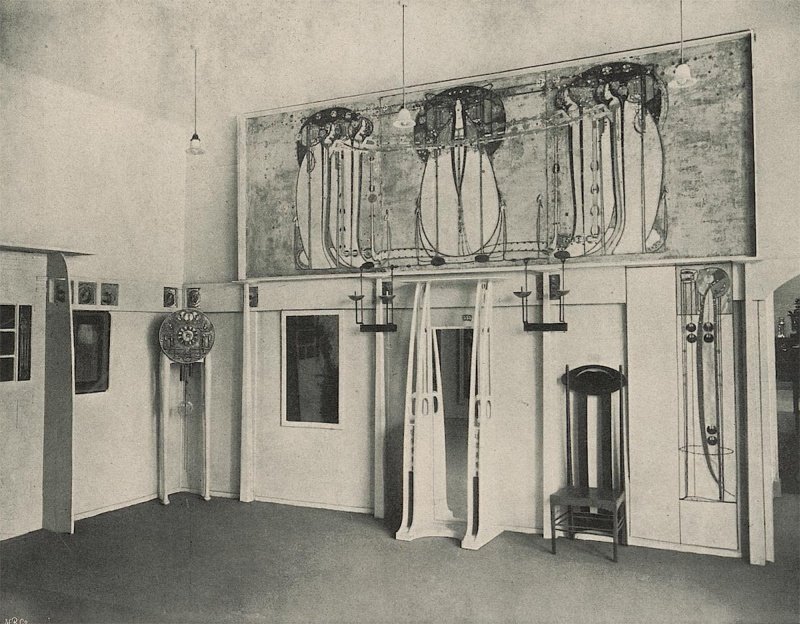Episode 18: Deadly Roses & Haunting Wells: Katsushika Hokusai - “House of Plates”, 1831-32 // Margaret Macdonald Mackintosh - “La Mort Parfumée (Perfumed Death)”, 1921
Katsushika Hokusai, House of Plates, 1831-32. Woodblock print on paper.
Margaret Macdonald Mackintosh, La Mort Parfumée (Perfumed Death), 1921. Watercolor, gouache, gold paint on paper. 24.8 x 28.03 in.
Spookephanie Dueñas and Russell Cryptmaker are back for this special Creature Double Feature episode to lift the spooky spirits by discussing - not one but two - goulish works, from two different continents, separated by a century, but sharing eerie similarities like gruesome stories of doomed protagonists:
A woodblock print, House of Plates, 1831-32 by Japanese Ukiyo-e master Katsushika Hokusai and the overlooked Scottish mixed media artist Margaret Macdonald Mackintosh’s painting, La Mort Parfumée (Perfumed Death) from 1921.
In Part One, they briefly discuss the environment in which Ukiyo-e blossomed in 17th - 19th century Japan, 3 ghostly prints from Katsushika Hokusai’s series One Hundred Ghost Stories and the Featured: House of Plates print while discovering that Okiku’s story ends . . . well (no bueno).
In Part Two, they introduce the 1913 play, La Pisanelle written by Gabriele D’ Annunzio* which inspired Margaret’s Featured work: La Mort Parfumée (perfumed Death). They also dive into Margaret’s life as she rejected Victorian gender roles and ideologies; her mesmerizing work, which embodied the Glasgow Style, as well as her overlooked contributions to art history, especially the Arts and Crafts and Art Nouveau movements that would inspire artists like Gustav Klimt from Vienna.
Topics include: Weird Al & Hawaiian shirts, triggering Glassdoor HR responses, playing pinball with plate-bodied ghosts and big, floppy bow ties.
*Gabriele D’Annunzio was a POS who inspired fascism and Margaret was likely unaware/had no connection to this when she saw and/or heard of the play.
Be sure to listen to all the cuts that didn’t make it into the episode on our Patreon.
The Art Pantry this week is Rhythm.
Special thanks to Bryan Knotts, designer of our Art Slice pizza box logo, for lending us his voice for the intro.
Consider subscribing and leaving us a review on apple podcasts.
Portrait of Hokusai by Keisai Eisen. c.1848.
Katsushika Hokusai, The Great Wave off Kanagawa from series 36 Views of Mt. Fuji, woodblock print on paper. c. 1830-32
Katsushika Hokusai, Fine Wind, Clear Morning, from series Thirty-Six Views of Mount Fuji, woodblock print on paper. c. 1830-32
Katsushika Hokusai, The Laughing Hannya (Warai-hannya), Woodblock print. c. 1831.
Katsushika Hokusai, The Ghost of Oiwa (Oiwa-san), Woodblock print. c. 1831.
Katsushika Hokusai, Kohada Koheiji (こはだ小平二), Woodblock print. c. 1831.
@artslicepod New episode of Art Slice out this thursday! #margaretmacdonaldmackintosh #hokusai #charlesrenniemackintosh #arthistorytok #arthistory #noface ♬ original sound - ArtSlice Palatable Art History
* * CONTENT WARNING : IMAGE OF BROWN / BLACK FACE BELOW * *
Scene from the play La Pisanelle, 1913. Paris, France.
Margaret MacDonald Mackintosh, by James Craig Annan. Modern bromide print, c. 1901.
Co-ed drawing class c. 1890s.
Embroidery class, Glasgow School of Art, c. 1890s.
Glasgow “Immortals” art group, Margaret Macdonald Mackintosh (far left), Charles Rennie Mackintosh (center front row), James McNair (far left center), Frances Macdonald (far back, center) c. 1890s.
An example of Charles Rennie Mackintosh’s furniture design, one of his high-backed chairs. This design embodies the Glasgow Style and the Spook School’s ‘aesthetic’.
Margaret Macdonald Mackintosh, Summer, pencil, watercolour and gouache on vellum. 1897.
Margaret Macdonald Mackintosh, Winter, pencil, watercolour and gouache on vellum. 1898.
“The Skinny Ladies” , linen embroidered with silk and metal threads in satin stitch and couching with silk braid, ribbon, silk appliqué, glass beads, square linen buttons painted gold. The faces are painted in watercolour on white kid stretched over the card, by Margaret Macdonald Mackintosh, 1902. The Hill House in Glasgow, Scotland. 16.1 × 69.6 in.
"The Skinny Ladies”, 1902, installed at The Hill House, Glasgow, Scotland.
Margaret Macdonald Mackintoshes, The May Queen mixed media panels installed in the Mackintosh’s exhibit for the 1900 Vienna Secession in Austria; how Gustav Klimt would have experienced their work.
Margaret Macdonald Mackintosh, The May Queen , oil-painted gesso on hessian and scrim, twine, shells, glass beads, tin, and painted plaster “jewels”. 1900 at the Vienna Secession. H 62.5 in. x W 180 in.
Margaret Macdonald Mackintosh, The May Queen (center panel), oil-painted gesso on hessian and scrim, twine, shells, glass beads, tin, and painted plaster “jewels”. 1900 at the Vienna Secession. H 62.5 in. x W 180 in.
Margaret Macdonald Mackintosh, The May Queen (Detail, center panel), oil-painted gesso on hessian and scrim, twine, shells, glass beads, tin, and painted plaster “jewels”. 1900 at the Vienna Secession. H 62.5 in. x W 180 in.
Margaret Macdonald Mackintosh, The May Queen (left panel), oil-painted gesso on hessian and scrim, twine, shells, glass beads, tin, and painted plaster “jewels”. 1900 at the Vienna Secession. H 62.5 in. x W 180 in.
Margaret Macdonald Mackintosh, The May Queen (right panel), oil-painted gesso on hessian and scrim, twine, shells, glass beads, tin, and painted plaster “jewels”. 1900 at the Vienna Secession. H 62.5 in. x W 180 in.
Said to have been inspired by Margaret’s The May Queen:
Gustav Klimt’s Beethoven Frieze, Gold, Graphite, Casein paint. 1902. Painted for the Vienna Secession Exhibition in 1902. 7′ 1″ x 112′
Margaret Macdonald Mackintosh, La Mort Parfumée (Perfumed Death), 1921. Watercolor, gouache, gold paint on paper.
@artslicepod New episode of Art Slice out this thursday! #margaretmacdonaldmackintosh #hokusai #charlesrenniemackintosh #arthistorytok #arthistory #noface ♬ original sound - ArtSlice Palatable Art History
Everett Millais, Ophelia, oil on canvas. 1851-52. 30.0 in × 44.0 in
Margaret Macdonald Mackintosh, The Legend of the Blackthornes, Watercolor and gouache on paper. 1922. 15 ¾ in. x 13 3/8 in.






























